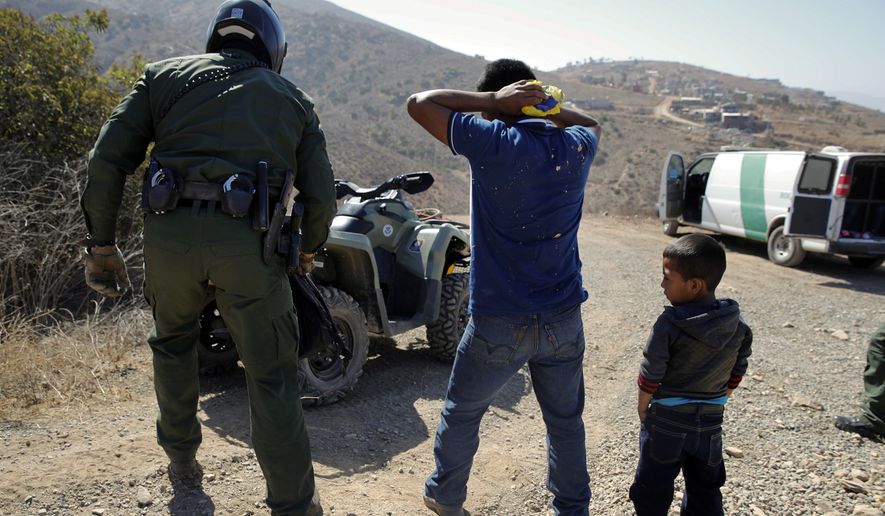Border authorities have identified more than 1,000 “fake families” over the past seven months featuring adults trying to use children who aren’t their own to sneak into the U.S.
Homeland Security officials revealed the number Wednesday as they announced a pilot program to begin using DNA testing to match children and the adults trying to sneak across the U.S.-Mexico boundary with them.
“It’s definitely an escalating trend that we’re seeing,” one department official said of the fraudulent families.
As the border spirals further out of control, President Trump sent Congress a request Wednesday for an emergency $4.5 billion infusion this year, warning that without the money the federal Health and Human Services Department will run out of cash to care for unaccompanied migrant children.
HHS officials also acknowledged that a 16-year-old unaccompanied boy died in the custody of one of its contract shelters.
The boy, who wasn’t identified beyond being Guatemalan, was arrested last month and sent to HHS on April 20 with no health complaints. The next morning, he became ill and had stints in and out of the hospital before being admitted finally on April 22. He remained in intensive care until he died Tuesday.
Immigrant rights groups called the unidentified boy a martyr to President Trump’s immigration policy.
“Too many children have lost their lives in the custody of our government. President Trump should be ashamed,” said Jess Morales Rocketto, chair of Families Belong Together.
The Guatemalan boy apparently arrived at the border alone.
More common now is families showing up, hoping to take advantage of lax U.S. laws that give adults with children a virtual get-out-of-detention card. Under a 2015 court ruling, they can be held for only 20 days — too short for their cases to be completed.
Instead, they are released, and few bother to show up for their court proceedings and deportations.
It’s so common that adults have begun to abduct or borrow children to pose as families — sparking the need for the DNA testing.
“The whole goal here is to identify these fake family units,” an official said.
The Washington Times has reported over the past year on the fraudulent families phenomenon, which is growing rapidly.
Border officials detected just 46 cases in all of fiscal year 2017, or about one every 10 days. By last year at this time, the rate was about one a day.
Through the first seven months of fiscal year 2019, there have been more than 1,000 cases, or a rate of about five a day — five times last year.
U.S. Immigration and Customs Enforcement has deployed special teams to the border to step up investigations. Over the past two weeks, they’ve produced information that’s led to 33 prosecutions, officials said.
The DNA testing is the next step.
The pilot program will ask adults whether they and the children they’re traveling with consent to being swabbed. Officials said the DNA swabs are immediately destroyed, but within a couple of hours agents will get back results showing whether the adult and child are related.
Fake families are those in which the adult isn’t a parent.
Authorities say that under the law, cases where an older sibling, aunt or uncle or grandparent are caught with the child all must be treated as fraudulent families and the children deemed unaccompanied and put into HHS shelters.
More than 38,000 unaccompanied children have been nabbed at the border over the last seven months, and authorities say they’re on track for the worst year on record.
At this pace, they’ll run out of money at HHS to house and care for the migrants in June.
They’ll then have to make tough decisions about pulling money from refugee funds or money to combat human trafficking, a senior official said.
“The situation at the border becomes more dire each day,” the official said. “It is worsening. Agencies are literally running out of funds.”
That spurred the $4.5 billion emergency money request.
Of that, $3.3 billion would go to caring for children and families at the border and in HHS care.
Another $1.1 billion would go for enforcement operations and support, such as paying for the extended deployment of military troops and trying to entice frustrated Border Patrol agents and Customs and Border Protection officers to stay on the job.
The administration said none of the money would go toward Mr. Trump’s border wall.
That, however, was of little comfort to Democrats who took an antagonistic approach to the emergency request.
Rep. Lucille Roybal-Allard, California Democrat and chair of the House subcommittee that oversees Homeland Security spending, said some of the money would go to improve ICE detention capabilities.
For a party where a number of lawmakers want to abolish ICE altogether, additional money is a tough sell.
Rep. Rosa L. DeLauro, Connecticut Democrat and chair of the subcommittee that oversees HHS, said she was tiring of having that department tapped to help on immigration.
“I will not agree to additional funding that continues the use of HHS agencies to enforce immigration policy. That is not HHS’s job,” she said.
Administration officials say Congress made it HHS’s job by law, taking the role of caring for children away from the then-Immigration and Naturalization Service and giving it to HHS, which was seen as more child-friendly.
A small bit of bipartisanship did poke through Wednesday.
Sen. John Cornyn, Texas Republican, and Rep. Henry Cuellar, Texas Democrat, said they’ll be announcing legislation Thursday to solve the ongoing border crisis with a bill streamlining the detention process and boosting the ranks of border authorities.
• Dave Boyer can be reached at dboyer@washingtontimes.com.
• Stephen Dinan can be reached at sdinan@washingtontimes.com.




Please read our comment policy before commenting.